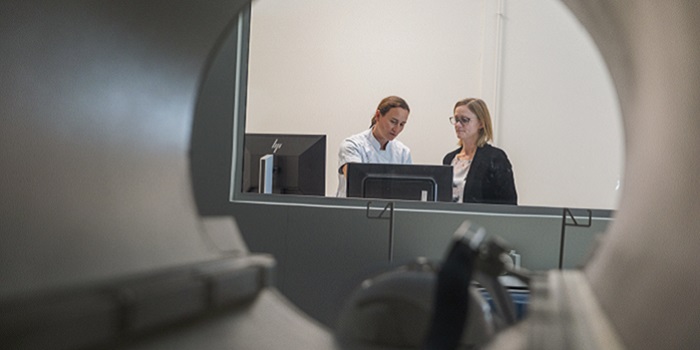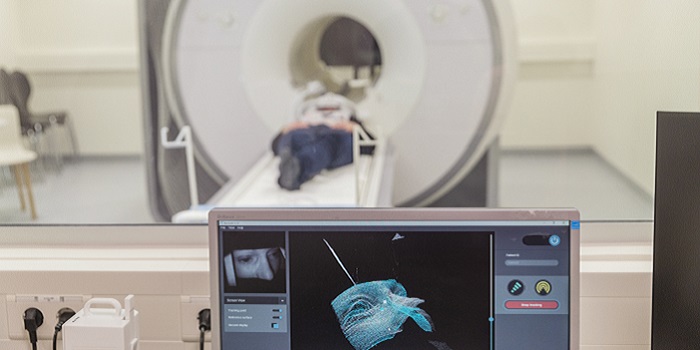Many believe that the Danish healthcare system only comprises doctors, nurses and other health professionals. In actual fact, another professional group is playing an increasingly important role; namely engineers.
The latest figures from the Danish Society of Engineers (IDA) show that from 2010-2019 the number of qualified MSc Eng and BEng graduates in the healthcare system increased by 22 per cent. In 2019 this meant that 553 engineers were directly employed in healthcare.
In 2003 Liselotte Højgaard, professor at the University of Copenhagen, honorary professor at DTU, and Head of the Department Clinical Physiology, Nuclear Medicine & PET at Rigshospitalet, helped to establish the fusion programme Medicine and Technology.
The programme was created in a collaboration between DTU and the University of Copenhagen and many of the engineers currently working in the healthcare system today are graduates of the programme. According to Liselotte Højgaard these engineers have had a great impact on innovation in health.
“In the collaboration with DTU, the vision of the technological revolution in hospitals has become a reality. Now new ideas arise on-location in the hospital. There are several examples of good ideas that have come into being because MSc Eng students or graduates were standing next to doctors, nurses, or physiotherapists and were able to solve a specific need,” she says.
Idea arose at Rigshospitalet
One of the engineers who came up with a good idea by looking over the doctors’ shoulders is Oline Vinter Olesen.
She graduated from Medicine and Technology in 2008 and the same year, she wrote her MSc thesis on a widespread problem in hospitals with patients who move during brain scans. The movements are the cause of blurry and flawed scan images and this means that hospitals have to spend extra time and money scanning patients again or anaesthetizing them during scanning. The latter is particularly problematic, as studies have shown that anaesthetizing young children can damage the brain and impact subsequent development.
While working on her thesis, Oline Vinter Olesen was affiliated with Rigshospitalet which intended to solve the problem by using motion-sensitive markers which was attached to the patient’s head. But she quickly became sceptical.
“When I saw the system in use, all my alarm bells started to ring, and I thought to myself: there has to be a better way of doing things. The hospital’s solution is far too time consuming and complex for a busy hospital environment,” she says.

Oline Vinter Olesen (to the right) has worked closely with Danish and international doctors. Both during her studies and in her later career. Here she’s at Rigshospitalet. (Photo: Ulrik Jantzen)
The solution also did not take into account the comfort of patients, as the attached markers were bothersome. This, combined with the lack of consideration for the doctors work routines, gave Oline Vinter Olesen an idea.
“I thought: it has to be simple. Why not make a push button solution? At a time when we use cameras to control our cars, brush our teeth, and everything else, we must be able to apply the same technology here, so staff don’t have to stick gizmos on patients. The solution must be a 3D camera,” she says.
‘With engineers on board, we can move frontiers ourselves’
Since 2008, Oline Vinter Olesen along with 535 other qualified MSc Eng graduates from the interdisciplinary Medicine and Technology programme has helped to streamline the Danish healthcare system.
"Without the engineers we would always be one step behind. But with the engineers on board, we can move the frontier ourselves."
Liselotte Højgaard, Head of Department at Rigshospitalet
The engineers work with everything from analysis of biological data using algorithms to the development of digital health platforms—and they are employed in the private sector, the Danish regions, municipalities, authorities, and hospitals.
“Over the last 20 years, high tech has exploded—including in hospitals. The equipment available today is so sophisticated that doctors and nurses can’t fully exploit its potential. Here in the department, we perform 130,000 examinations a year, and we have equipment worth DKK 600 million, so we need the engineers,” says Head of Department, Liselotte Højgaard. At her Department of Clinical Physiology, Nuclear Medicine & PET at Rigshospitalet, the proportion of engineers has increased from two to 20 since the start of the millennium.
In addition to maintaining operations, Liselotte Højgaard says that the engineers greatly contribute to new development, research and new thinking in collaboration with the doctors.
“If we didn’t have this interdisciplinary approach, we wouldn’t have had the high level of research we now have. Optimizing images is really important, especially in the area of personalized medicine where genes and biochemistry are used to predict how patients should be treated. Big data is important—as is AI. Without the engineers to develop these areas, we would always be one step behind. But with the engineers on board, we can move the frontier ourselves,” says Liselotte Højgaard.
3D camera solution makes an international impression
Cooperation with doctors is also of great importance to engineers.
For Oline Vinter Olesen, her stay at Rigshospitalet allowed her to develop an advanced 3D camera solution that can prevent blurry scan images. Mounted on a PET or MRI scanner’s main coil, the camera tracks the patient’s movements in 3D, allowing the scanner to correct the images en route.
With the help of radiographers, doctors, and researchers from Rigshospitalet and DTU, Oline Vinter Olesen has initiated collaborations with Siemens, Harvard Medical School, and Massachusetts General Hospital to commercialize the solution and in 2015 this led to the founding of the company TracInnovations.
“The constellation with the various collaborators has been crucial on my journey to commercializing my solution. I’ve had the right stakeholders on board and have had access to the right places. That’s what has opened the doors for me—initially because of the support I received from the people on my study programme,” she says.

The camera is mounted on the scanner and tracks the patient’s movements while the scan is taking place. The doctors can follow the movements in 3D at a screen as here at Rigshospitalet. Today it is possible to correct the images retrospectively. The expectation is that within a year it will be possible to correct them in real time. (Photo: Ulrik Jantzen)
Currently, hospitals in six different countries use her solution to monitor and correct scan images in research. The expectation from TracInnovations is that a more integrated setup for clinical use will be ready within about a year, so that patients around the world can benefit from the solution.
“It started with a good idea at Rigshospitalet, and this year I have pushed a growing company forward with 12 employees and the potential to make a big impression—both in terms of economics and patient care. Of course, I’m incredibly proud,” says Oline Vinter Olesen, who at the beginning of 2021 chose to sell her share of TracInnovations.
She is currently employed by the medical company Ferrosan Medical Devices.
.